![]()
![]()
![]()
Use LEFT and RIGHT arrow keys to navigate between flashcards;
Use UP and DOWN arrow keys to flip the card;
H to show hint;
A reads text to speech;
68 Cards in this Set
- Front
- Back
|
What is an important mechanism for sudden death in Chagas disease?
|
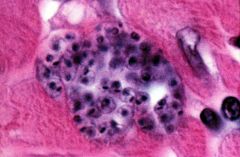
Sudden death occurs due to parasitization of the cardiac conduction system (AV node or some other cardiac bundle), leading to acute death due to fatal dysrhythmia.
|
|
|
What species of parasites is responsible for African sleeping sickness, and what is one characteristic physical manifestation?
|
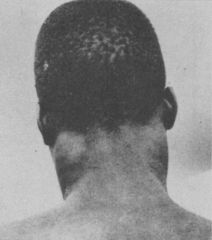
Trypanosoma brucei (think brucei sounds like "droopy eye" for sleeping). Winter bottom's sign is pathognomonic for African sleeping sickness
|
|
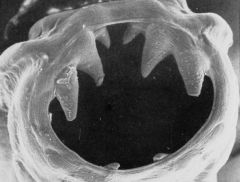
What parasite looks like this?
|
Hookworm. They have rudimentary teeth-like structures that allow them to burrow in and hold on. Larval penetration causes severe itching and leads to production of maculopapules and localized erythema.
|
|
|
Are schistosomes hermaphroditic?
|
No, schistosomes have a male and female. However, most trematodes (flukes) are hermaphroditic.
|
|
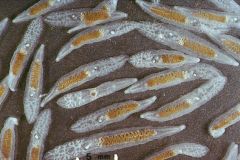
What family of parasites do schistosomes belong to?
|
Schistosomes are trematodes.
|
|
|
What is the main driver of disease in schistosomiasis?
|

The eggs produced by the schistosomes cause the formation of granulomas which cause disease. For instance, the eggs clog up the liver, leading to portal HTN, which causes the distinctive ascites visualized in carriers (distended abdomens).
|
|
|
What trematode causes clonorchiasis?
|
Clonorchis sinensis causes clonorchiasis, which is the Chinese liver fluke. Most pathologic manifestations result from inflammation and intermittent obstruction of the biliary ducts. In the acute phase, abdominal pain, nausea, diarrhea, and eosinophilia can occur. In long-standing infections, cholangitis, cholelithiasis, pancreatitis, and cholangiocarcinoma can develop, which may be fatal.
|
|
|
Which worm depletes us of vitamin B12?
|
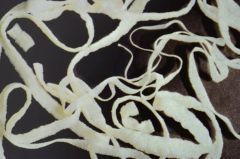
The fish tapeworm depletes us of viamin B12 (the cestode Diphyllobothrium latum)
|
|
|
What is the common name for cestodes?
|
Cestodes are commonly referred to as Tapeworms.
|
|
|
Which tapeworm is the beef tapeworm?
|
Taenia saginata is the beef tapeworm.
|
|
|
Which tapeworm is the pork tapeworm?
|
The pork tapeworm is Taenia solium. It has the same life cycle as the beef tapeworm (T. saginata).
|
|
|
What is cystericosis?
|
– central nervous system disease
– seizures, focal deficits, hydrocephalus (ventricular cysts) – ocular disease |
|
|
What are the intestinal tapeworms?
|
Diphyllobothrium latum (fish tape worm), Taenia saginata (beef tapeworm), and Taenia sollium (pork tape worm) are the intestinal tapeworms. There’s an extraintestinal tape worm called ecchinocus granulosus.
|
|
|
Which nematode can be removed with a match stick?
|
The guinea worm can be removed with a match stick, but be careful that it doesn’t break, because it could cause massive inflammation and necrotizing fasciitis.
|
|
|
Which of the following are most like humans: nematodes, cestodes, trematodes?
|
Nematodes have bilateral symmetry and almost all the organ systems that humans do.
|
|
|
What organism causes small boys to scratch their bottoms (pruritus ani)?
|
Pinworm infection (Enterobias vermicularis) causes pruritus ani.
|
|
|
What is the most common helminth?
|
Pinworm (Enterobias vermicularis)
|
|
|
How long do pinworms have to mature in the soil? How about whipworms?
|
5-6 hours for pinworms, 10 days for whip worms (at least).
|
|
|
What’s a significant difference between pinworms and whipworms in terms of their infection?
|
Whipworms adhere, and pinworms do not adhere.
|
|
|
Which worm causes prolapsed rectum?
|
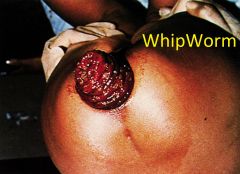
The whipworm causes prolapsed rectum.
|
|
|
Which worms are the largest intestinal nematodes?
|
Ascaris lumbricoides (The large roundworm) is the largest intestinal nematode.
|
|
|
How are large roundworms transmitted?
|
Transmission from by consumption of vegetables if nightsoil used for fertilization
|
|
|
Which worm causes Loeffler’s syndrome?
|
Ascaris Lumbricoides (Large roundworm infection) causes Loeffler’s syndrome: Löeffler's syndrome: transient infiltration of lungs, cough, fever, dyspnea, eosinophilia
|
|
|
Which worm has females that are parthenogenetic (can replicate without males?)
|
Strongyloides (causes Strongyloidiasis). They are strong, independent women that don’t need no man to procreate. (They look like pinworms)
|
|
|
What disease or physical manifestations are caused by strongyloidiasis?
|
Strongyloidiasis cause: larva currens (rash and eosinophilia) and migratory pneumonitis
|
|
|
What organism causes river blindness?
|
Onchocerca volvulus
|
|
|
What organism(s) cause elephantiasis, and what is the pathophysiologic mechanism?
|
Wuchereria bancrofti and Brugia malayi cause elephantiasis. The adult worms reside in lymphatic vessels and nodes (especially inguinal, epitrochlear, axillary, testicular, epididymal) and block the lymphatic return of the circulation, which leads to accumulation of fluid, causing elephantiasis. The Brugia malayi happens more in lower extremities than the genital area, where Bancroftian filiarisis occurs.
|
|
|
What does loa loa do in terms of disease?
|

Loa loa causes calabar swelling. (Think of the young man who put up his dukes.)
|
|
|
What disease characteristics are caused by Trichinosis?
|
– common symptoms
l orbital edema l muscle pain, respiratory distress, headache and generalized weakness l myocardial and central nervous system involvement also produces signs and symptoms |
|
|
What is described by: most primitive of protozoa; multiplies by binary fission and moves by means of cytoplasmic organelles called pseudopodia?
|
amoeba (rhizopod); 90% of people are asymptomatic passers
|
|
|
What’s the difference between definitive, intermediate, and paratenic host?
|
A definitive host harbors the adult (sexual) stage of the parasite.
An intermediate host harbors the larval (asexual) stage of the parasite. A paratenic host harbors a form that doesn’t undergo development. |
|
|
Among the free-living ciliates, only what pathogen causes disease in humans, and what is its major reservoir?
|
Balantidium coli (Balantidiasis); pigs
|
|
|
What are the reservoirs of Giardia lamblia?
|
Humans and beavers; isolated cases in hikers and campers who drink untreated water
|
|
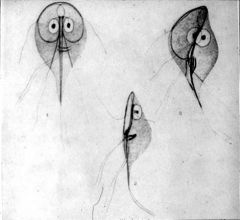
Which parasites “look back at you” from the microscopic view?
|
Giardia lamblia
|
|
|
What’s the most common cause of primary amoebic meningoencephalitis?
|
Naegleria fowleri, found in fresh water, soil; occurs during summer months in individuals who have been in contaminated water
|
|
|
What flagellate causes African sleeping sickness, and what is its means of transmission?
|
African Sleeping Sickness is caused by flagellate Trypanosoma brucei, and the insect vector is the tsetse fly.
|
|
|
What disease are VSGs in the context of?
|
Variant Surface Glycogene (coat proteins) are in the context of African Sleeping Sickness
|
|
|
What are clinical manifestations of African Sleeping System?
|
hypoglycemia
|
|
|
Which insect causes East African versus West African sleeping sickness?
|
East African -> T.b. rhodesiense
West African -> T.b. gambiense |
|
|
Which disease has Winterbottom’s sign?
|

East African Sleeping disease: occipital lymphadenopathy
|
|
|
What causes Chagas’ disease, and what is the clinical manifestation?
|
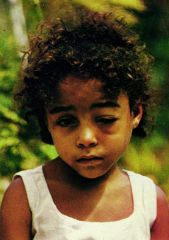
Chagas’ disease is caused by flagellate Trypanosoma cruzi; insect vector reduviid bug. The disease manifests with:
Acute phase: periorbital edema (Romana’s sign), fever, anorexia, hepatomegaly, lymphadenopathy. Chronic phase: cardiomyopathy, megaesophagus, megacolon |
|
|
What are some clinical manifestations of Leishmaniasis?
|

cutaneous (oriental sore): chronic, non-healing ulcer with heaped-up margins
visceral (kala azar): parasites in macrophages of reticuloendothelial system mucocutaneous (espundia): occurs months to years after cutaneous infection with L. braziliensis; mutilating disease of cartilage |
|
|
What is the vector for Leishmania?
|
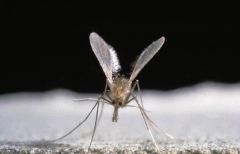
The vector is the sandfly
|
|
|
What genus causes malaria?
|
Plasmodium; vector is the mosquito
|
|
|
What are clinical manifestations of malarial infection?
|
fever, anemia (due to erythrocytic cycle where RBCs are destroyed),
|
|
|
What is the most severe malaria?
|
P. falciparum infection is a medical emergency
|
|
|
What are disease properties of Trichomoniasis, and how is the diagnosis made?
|
Disease properties include vaginitis, prostatitis, urethritis, and the diagnosis is made by detection of trophozoites in vaginal discharge or urethral exudate.
|
|
|
What are the mechanisms of death/disease in African Sleeping Sickness?
|
hypoglycemia, low flow
|
|
|
What is the vector for Chagas' disease and the name of the parasite?
|
Chagas' disease is caused by Trypanosoma cruzi, and the vector is aon insect called reduviid bug (kissing bug)
|
|
|
What disease is caused by Trichomonas vaginalis, how is the disease spread, and what are disease manifestations?
|
Trichomoniasis is caused by Trichomonas vaginalis. It has veneral transmission, and it can cause vaginitis, prostatitis, and urethritis.
|
|
|
Which parasites are transmitted via the fecal-oral route?
|
1. Entamoeba histolytica (Amebiasis): 90% asymptomatic cyst passers; acute rectocolitis, rarely toxic megacolon, ameboma, acute amebic appendicitis
2. Giardia lamblia: reservoirs are humans and beavers; isolated cases in hikers and campers who drink untreated water. Produces bloating, gas, chronic diarrhea, epigastric pain, malabsorption. 3. Cryptosporidium spp.:obligate intracellular. Produces watery diarrhea, more severe (leads to death) in immunocompromised (e.g., AIDs) patients. 4. Enterobius vermicularis (Enterobiasis) (pinworm): most common helminth; pruritus ani 5. Trichuriasis trichiura: protein calorie malnutrition, rectal prolapse, inflammatory diarrhea 6. Ascaris lumbricoides: fecal-oral, consumption of vegetables/night soil, Loeffler’s syndrome 7. Toxoplasma gondii (Toxoplasmosis: transmission after humans ingest oocysts found in cat feces or tissue cysts in uncooked contaminated meat. No symptoms or mononucleosis-like symptoms. Could cause encephalitis, pneumonitis, myocarditis, chorioretinitis. |
|
|
Which parasites transmit by penetrating the skin?
|
1. The subset larva migrans, Ancylostoma braziliense, the cat and dog hook worm. Acquired by direct penetration; classic feature is serpiginous line of eruption that reflects movement of larva beneath skin.
2. Schistosomes 3. Strongyloides stercoralis: females are parthenogenetic, worldwide distribution but more prevalent in warm climates, human only definitive host, migratory pneumonitis, hyper infection of 4. Hookworm |
|
|
Which parasites have something to do with pigs?
|
1. Trichinella spiralis is a roundworm widespread in wild mammals, including both wild and domestic pigs. Most common symptoms are orbital edema, muscle pain, respiratory distress, headache and generalized weakness; myocardial and CNS. Ingestion of poorly cooked pork could lead diagnosis.
2. Balantidium coli has the pig as its major reservoir; acquired from food/water ingested that’s contaminated with swine excrement; most infected individuals are asymptomatic; dysentery-like illness may occur 3. Fasciolopsis buski (Fasciolopsiasis): pig is reservoir. Clinical presentation—epigastric pain, nausea, diarrhea, intestinal obstruction 4. Taenia solium (Taeniasis/Pork Tapeworm infection): pig is usual intermediate host. Man may serve as an intermediate host. Clinical properties: dull, colicky abdominal pain. cysticercosis: CNS system disease include seizures, focal deficits, hydrocephalus, ocular disease |
|
|
Which parasites have something to do with dogs and cats?
|
1. Of the subset Larva migrans, Toxocara canis (dog ascarid) or toxocara cati (cat scarid). Dogs and cats are important reservoirs, transmitted by oral route (eggs). Hepatomegaly common.
2. Also of the subset larva migrans, Ancylostoma braziliense, the cat and dog hook worm. Acquired by direct penetration; classic feature is serpiginous line of eruption that reflects movement of larva beneath skin. 3. Toxoplasma gondii: both sexual and asexual cycles in cat, the definitive host; 1 of every 500 pregnant women acquire toxoplasmosis->parasite transmitted to fetus in half of these women. Acute disease has no symptoms or mononucleosis like symptoms. In immunocrompromised: encephalitis, pneumonitis, myocarditis, chorioretinitis 4. Clonorchis sinensis (Chinese Liver Fluke): Dog and cat are reservoirs. human ingests undercooked fish. acute--fever, hepatomegaly, chronic—acute symptoms+RUQ pain, |
|
|
Which parasites have something to do with fish?
|
1. Clonorchis sinensis (Chinese Liver Fluke): human ingests undercooked fish. acute--fever, hepatomegaly, chronic—acute symptoms+RUQ pain,
2. Diphyllobothrium latum: human ingests undercooked freshwater fish. Disease properties—usually no symptoms, occasional megaloblastic anemia (worm utilizes vitamin B12) |
|
|
Which parasites go to the lungs, get coughed off, and then go to the intestines?
|
1. Ascaris lumbricoides: fecal-oral, consumption of vegetables/night soil, Loeffler’s syndrome
2. Ancylostoma duodenale (Hookworm): severe itching and maculopapules and localized erythema, anemia/protein malnutrition, diagnosis by eggs in feces 3. Strongyloides stercoralis: females are parthenogenetic, worldwide distribution but more prevalent in warm climates, human only definitive host, migratory pneumonitis, hyper infection of immunocrompromised may lead to meningitis, pneumonia; diagnosis by larvae in feces 4. Paragonimus westermani (paragonimiasis/Oriental Lung Fluke Infection): humans ingest undercooked seafood w/ cercariae infection. Clinical presentation: acute disease--eosinophilic inflammatory reaction w/ fever, urticarial, cough, dyspnea, abdominal pain, bloody diarrhea. Chronic disease—chronic pneumonia, lung abscess. |
|
|
Which parasites have diagnosis by eggs/larvae in the feces?
|
1. Schistosome (schistosomiasis): clinical presentation—acute schistosomiasis/katayama fever: (occurs 4-6weeks after heavy primary infection) due to release of egg antigen, Ag-Ab complexes, resembles serum sickness (immune complex deposition, tissue damage resulting from actions of complement and neutrophils); cercarial dermatitis; chronic schistosomiasis: granulomatous reaction to eggs in tissues (Th1->Th2 immune responses), granulomatous hepatosplenomegaly, periportal fibrosis and portal HTN, intractable ascites, esophageal varices, intestinal polyposis (protein-losing eneteropathy), urinary track schistosomiasis—dysuria, terminal hematuria, obstructive uropathy w/ pyelonephritis, gram negative rod bactermia->renal failure, pulmonary fibrosis, CNS involvement (seizures, transverse myelitis)
2. Ancylostoma duodenale (Hookworm): severe itching and maculopapules and localized erythema, anemia/protein malnutrition, diagnosis by eggs in feces 3. Strongyloides stercoralis: females are parthenogenetic, worldwide distribution but more prevalent in warm climates, human only definitive host, migratory pneumonitis, hyper infection of immunocrompromised may lead to meningitis, pneumonia; diagnosis by larvae in feces 4. Fasciolopsis buski (Fasciolopsiasis): pig is reservoir. Clinical presentation—epigastric pain, nausea, diarrhea, intestinal obstruction. Diagnosis made by detection of eggs in feces 5. Taenia saginata 6. Taenia solium 7. Diphyllobothriasis |
|
|
Which parasites need to mature in the soil?
|
1. Enterobius vermicularis (Pinworm)
2. Trichuris trichiura (Whipworm) 3. Ascaris Lumbricoides (Large Roundworm) |
|
|
Which parasites are transmitted by insects?
|
1. Trypanosoma brucei (African Sleeping Sickness) - tse tse fly
2. Onchoncero volvulus (River blindness) - blackfly 3. Loa loa (Loaisis) - horsefly 4. Trypanosoma cruzi (Chagas’ Disease) - reduviid bug (kissing bug) 5. Anopholes (Malaria) 6. Wuchereria brancrofti (elephantiasis) - mosquito 7. Brugia malayi (elephantiasis) - mosquito |
|
|
What are some clinical manifestations of malaria?
|
Fever, anemia, hypoglycemia, splenomegaly, splenic rupture
|
|
|
Which parasites produce hepatomegaly?
|
1. Of the subset Larva migrans, Toxocara canis (dog ascarid) or toxocara cati (cat scarid). Dogs and cats are important reservoirs, transmitted by oral route (eggs). Hepatomegaly common.
2. Schistosomes (schistosomiasis) 3. Trypanosoma cruzi (Chagas disease) 4. Leishmania (Leishmaniasis)? |
|
|
Which form of the plasmodium protozoan infects the liver in malaria infection?
|

The Sporozoites infect the liver. They then become merozoites, and the merozoites then infect RBCs. Merozoites become trophozoites and then schizonts.
|
|
|
Which forms of malaria invade only reticulocytes?
|
P. vivax and P. ovale invade only reticulocytes. P malariae invades only mature erythrocytes, and P. falciparum invades everything.
|
|
|
What treatments are available for malaria?
|
1. Quinolones (aryl amino-alcohols). Best known; chloroquine, mefloquine, primaquine
2. Antifols and sulfas. Best known: pyrimethamine, trimethoprim 3. Artemisinins |
|
|
What is the duffy antigen, and how does it relate to malaria?
|
The Duffy antigen is a red cell surface antigen. Duffy is one of the ways that the plasmodium gets into the cells, so if you’re missing it, the range of blood cells that can get infected is different.
|
|
|
Can you describe the life cycle of toxoplasmosis and human’s role in parasite transmission?
|
Two stages, the sexual and asexual. Cats are required for gamete formation (cats are the definitive host). Consumption of infected meat may pass the asexual bradyzoites or tachyzoites into another carnivorous host. Cats may also defecate oocytes taken up by fecal-oral contamination into other cats or humans, which are generally an incidental terminal host.
|
|
|
What are three features of congenital infection with toxoplasmosis?
|
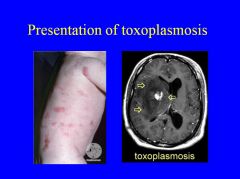
Microcephaly, hydrocephalus, CNS calcifications, chorioretinitis, fever, rash, and hepatomegaly
|
|
|
What is the challenge of using serology to diagnose toxoplasmosis?
|
High prevalence means that many are IgG positive. Only acute infections with IgM can be diagnosed serologically.
|

